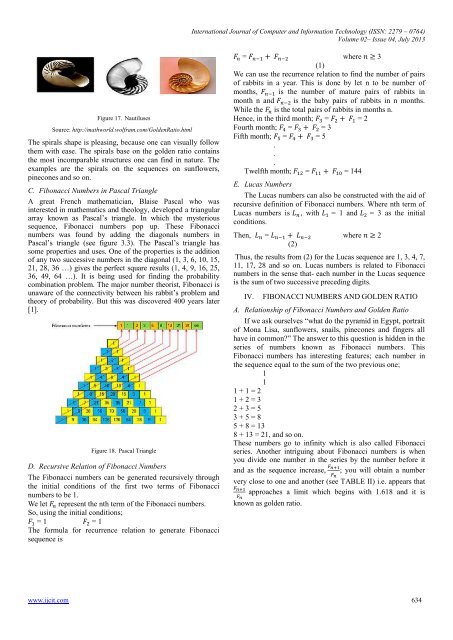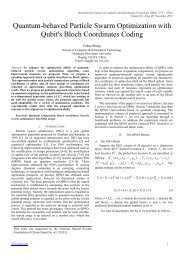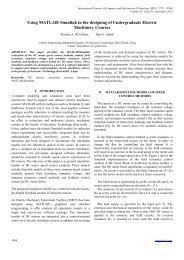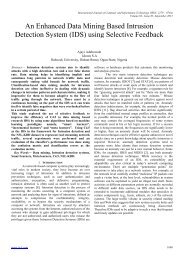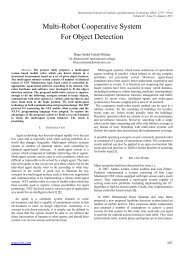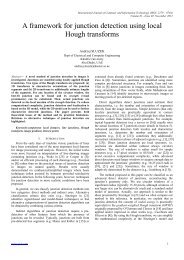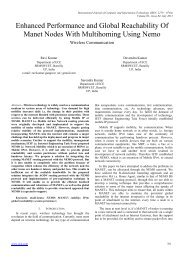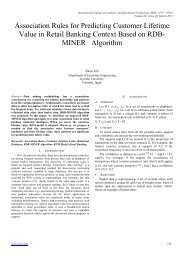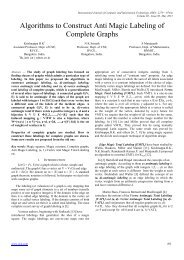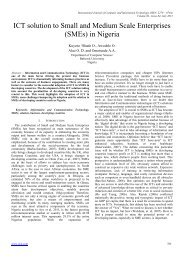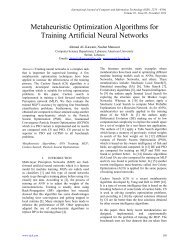Fibonacci Numbers and Golden Ratio in Mathematics and Science
Fibonacci Numbers and Golden Ratio in Mathematics and Science
Fibonacci Numbers and Golden Ratio in Mathematics and Science
You also want an ePaper? Increase the reach of your titles
YUMPU automatically turns print PDFs into web optimized ePapers that Google loves.
International Journal of Computer <strong>and</strong> Information Technology (ISSN: 2279 – 0764)<br />
Volume 02– Issue 04, July 2013<br />
Figure 17. Nautiluses<br />
Source: http://mathworld.wolfram.com/<strong>Golden</strong><strong>Ratio</strong>.html<br />
The spirals shape is pleas<strong>in</strong>g, because one can visually follow<br />
them with ease. The spirals base on the golden ratio conta<strong>in</strong>s<br />
the most <strong>in</strong>comparable structures one can f<strong>in</strong>d <strong>in</strong> nature. The<br />
examples are the spirals on the sequences on sunflowers,<br />
p<strong>in</strong>econes <strong>and</strong> so on.<br />
C. <strong>Fibonacci</strong> <strong>Numbers</strong> <strong>in</strong> Pascal Triangle<br />
A great French mathematician, Blaise Pascal who was<br />
<strong>in</strong>terested <strong>in</strong> mathematics <strong>and</strong> theology, developed a triangular<br />
array known as Pascal’s triangle. In which the mysterious<br />
sequence, <strong>Fibonacci</strong> numbers pop up. These <strong>Fibonacci</strong><br />
numbers was found by add<strong>in</strong>g the diagonals numbers <strong>in</strong><br />
Pascal’s triangle (see figure 3.3). The Pascal’s triangle has<br />
some properties <strong>and</strong> uses. One of the properties is the addition<br />
of any two successive numbers <strong>in</strong> the diagonal (1, 3, 6, 10, 15,<br />
21, 28, 36 …) gives the perfect square results (1, 4, 9, 16, 25,<br />
36, 49, 64 …). It is be<strong>in</strong>g used for f<strong>in</strong>d<strong>in</strong>g the probability<br />
comb<strong>in</strong>ation problem. The major number theorist, <strong>Fibonacci</strong> is<br />
unaware of the connectivity between his rabbit’s problem <strong>and</strong><br />
theory of probability. But this was discovered 400 years later<br />
[1].<br />
Figure 18. Pascal Triangle<br />
D. Recursive Relation of <strong>Fibonacci</strong> <strong>Numbers</strong><br />
The <strong>Fibonacci</strong> numbers can be generated recursively through<br />
the <strong>in</strong>itial conditions of the first two terms of <strong>Fibonacci</strong><br />
numbers to be 1.<br />
We let represent the nth term of the <strong>Fibonacci</strong> numbers.<br />
So, us<strong>in</strong>g the <strong>in</strong>itial conditions;<br />
= 1 = 1<br />
The formula for recurrence relation to generate <strong>Fibonacci</strong><br />
sequence is<br />
= where 3<br />
(1)<br />
We can use the recurrence relation to f<strong>in</strong>d the number of pairs<br />
of rabbits <strong>in</strong> a year. This is done by let n to be number of<br />
months, is the number of mature pairs of rabbits <strong>in</strong><br />
month n <strong>and</strong> is the baby pairs of rabbits <strong>in</strong> n months.<br />
While the is the total pairs of rabbits <strong>in</strong> months n.<br />
Hence, <strong>in</strong> the third month; = = 2<br />
Fourth month; = = 3<br />
Fifth month; = = 5<br />
.<br />
.<br />
.<br />
Twelfth month; = = 144<br />
E. Lucas <strong>Numbers</strong><br />
The Lucas numbers can also be constructed with the aid of<br />
recursive def<strong>in</strong>ition of <strong>Fibonacci</strong> numbers. Where nth term of<br />
Lucas numbers is , with = 1 <strong>and</strong> = 3 as the <strong>in</strong>itial<br />
conditions.<br />
Then, = where 2<br />
(2)<br />
Thus, the results from (2) for the Lucas sequence are 1, 3, 4, 7,<br />
11, 17, 28 <strong>and</strong> so on. Lucas numbers is related to <strong>Fibonacci</strong><br />
numbers <strong>in</strong> the sense that- each number <strong>in</strong> the Lucas sequence<br />
is the sum of two successive preced<strong>in</strong>g digits.<br />
IV.<br />
FIBONACCI NUMBERS AND GOLDEN RATIO<br />
A. Relationship of <strong>Fibonacci</strong> <strong>Numbers</strong> <strong>and</strong> <strong>Golden</strong> <strong>Ratio</strong><br />
If we ask ourselves “what do the pyramid <strong>in</strong> Egypt, portrait<br />
of Mona Lisa, sunflowers, snails, p<strong>in</strong>econes <strong>and</strong> f<strong>in</strong>gers all<br />
have <strong>in</strong> common?” The answer to this question is hidden <strong>in</strong> the<br />
series of numbers known as <strong>Fibonacci</strong> numbers. This<br />
<strong>Fibonacci</strong> numbers has <strong>in</strong>terest<strong>in</strong>g features; each number <strong>in</strong><br />
the sequence equal to the sum of the two previous one;<br />
1<br />
1<br />
1 + 1 = 2<br />
1 + 2 = 3<br />
2 + 3 = 5<br />
3 + 5 = 8<br />
5 + 8 = 13<br />
8 + 13 = 21, <strong>and</strong> so on.<br />
These numbers go to <strong>in</strong>f<strong>in</strong>ity which is also called <strong>Fibonacci</strong><br />
series. Another <strong>in</strong>trigu<strong>in</strong>g about <strong>Fibonacci</strong> numbers is when<br />
you divide one number <strong>in</strong> the series by the number before it<br />
<strong>and</strong> as the sequence <strong>in</strong>crease, ; you will obta<strong>in</strong> a number<br />
very close to one <strong>and</strong> another (see TABLE II) i.e. appears that<br />
approaches a limit which beg<strong>in</strong>s with 1.618 <strong>and</strong> it is<br />
known as golden ratio.<br />
www.ijcit.com 634


